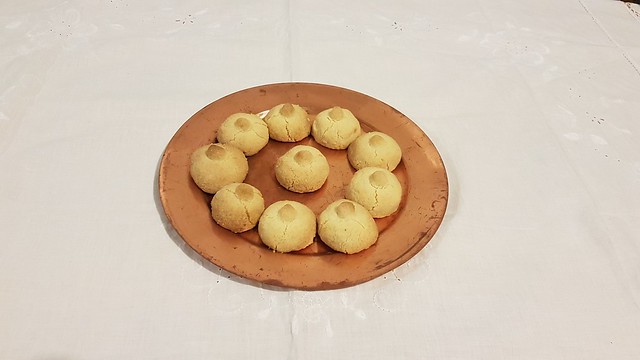Knead sugar, almonds, samid and clarified butter, equal parts, and make them like breasts, and arrange them on a brass tray. Put it in the bread oven until done, and take it out. It comes out excellently.
Kitab Wasf al-Atima al-Mutada Chapter XI (The Description of Familiar Foods, trans. Charles Perry)
Features in Medieival Arab Cookery, ed. Maxime Rodinson.
If I had to nominate a signature dish, this would probably be it. I have cooked this dish multiple times, and handed out the recipe many times as well (you can find the original recipe, along with the story of its development, here). It’s an easy recipe, the biscuits are delicious, and there is room for as much innuendo as you please.
However, the texture was slightly grainy. I put this down to the sugar, because it’s difficult to cream clarified butter and sugar together, and the sugar doesn’t completely dissolve. I have recently been revisiting Middle Eastern cooking with one of my apprentices, and I noticed there are recipes in various sources calling for powdered sugar (which in Australia is known as icing sugar). Knowing powdered sugar dissolves very quickly in any liquid (such as clarified butter), I wondered whether replacing the caster sugar with icing sugar would give a better result. It does. The resulting biscuits have a much smoother texture, and are easier to shape as the mix is moister.
Ingredients
| 200g clarified butter | 200g semolina |
| 200g icing sugar | 200g almond meal |
Method
- Preheat your oven to 180°C.
- Mix the semolina and almond meal in a bowl.
- If your clarified butter is not melted, melt it, and then combine with the sugar until the sugar is dissolved and the mixture is frothy. You can do this step with an electric mixer.
- Gradually add the combined semolina and almond meal to the butter and sugar – it is better to do this by hand.
- Take walnut sized balls of dough and press in to “breast” shapes. You can also mould small nipples and press them gently into the top of the “breasts.”
- Bake for around 12-15 minutes, until pale gold.
Notes
- Clarified butter, or ghee, is butter with the milk solids removed. To make it, heat butter over a gentle heat until it is completely melted and bubbling. You will see a white scum on the surface. These are the milk solids. Strain the melted butter through a strainer lined with a double layer of muslin and you will be left with lovely clear clarified butter. Because the solids are the bit that makes butter go rancid, clarified butter does not need to be stored in the fridge. Some lactose intolerant people are fine with clarified butter, as most of the lactose is removed with the solids. You will need about 250g of butter to get 200g of clarified butter, or you can buy ghee from Indian or Middle Eastern grocers.
- There is some debate about what samid is; it’s definitely some sort of wheat product, but it’s not normal wheat flour. Charles Perry believes it’s fine semolina (Perry, 2005, 22), which is made from durum wheat, also used to make pasta. It’s coarser than ordinary wheat flour. However, Nawal Nasrallah believes it’s finer than ordinary flour, in which case it would be similar to wheaten cornflour(Nasrallah, 2009, 573).
Based on my own experimentation, I get better results from semolina, as wheaten cornflour loses too much structure in cooking, and you wind up with mush rather than dough. However , make sure you get fine semolina rather than coarse, as coarse semolina feels like sand in the mouth. - The original recipe specifies a “bread oven” temperature, which normally would mean a very hot oven. However, I have found that cooking the breasts at a temperature above 180°C leads to them burning quickly, while the middle is uncooked. And no one likes burned breasts.

Further Reading
Click on the links below to order books directly from the Book Depository.
Nasrallah, Nawal (2009). Annals of the Caliphs’ Kitchens
Perry, Charles (2005). A Baghdad Cookery Book
Rodinson, Maxime (2006). Medieval Arab Cookery
Given the name, I’m thinking that serving Virgin’s Breasts with cherry preserves would be amusing.
LikeLike
You are not kidding about the grade of semolina. I made a half batch with medium semolina as a test, weighing each ingredient to be sure. They spread out into sugar cookies. I just sent the kids to the Indian grocery store to get fine semolina, I’ll report back after the next test.
LikeLike
Not edited by Maxime Rodinson, who died long before this book, Medieval Arab Cookery, was published.
And the Kitab Wasf was translated by Charles Perry.
LikeLike